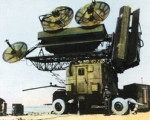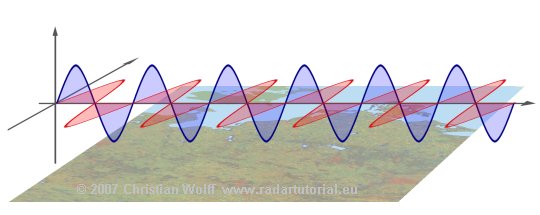Polarization of electromagnetic waves

Figure 1: missile-guidance radar S 75 „Fan Song E”
Source of the picture: www.pvo.guns.ru
The radiation field of an antenna is composed of electric and magnetic lines of force. In this field emitted by an antenna, the lines of force of the electric field are perpendicular to the magnetic field. Both field components depend on the position of the antenna relative to the earth's surface. The direction of the electric field determines the direction of the polarization of the electromagnetic wave. A distinction is declared between linear and circular polarization.

Figure 2: vertically linear polarized electric field (blue) and horizontally linear polarized electric field (red)
Linear Polarization
Vertically and horizontally mounted antennas are designed to transmit or receive vertically and horizontally polarized waves, respectively. Therefore, changes in polarization cause changes in the magnitude of the received signal due to the inability of the antenna to receive polarization changes.
Two main forms of polarization can be obtained from linear polarization:
- In a vertically polarized wave, the electric lines of force lie in a vertical direction.
- In a horizontally polarized wave, the electric lines of force lie in a horizontal direction.
e.g., Surveillance- (Search-) antennae of the missile-guidance radar of the SA-2 missile system.
The maximum pickup will result when the Rx-antenna is oriented in the same direction as the Tx-antenna.

Figure 4: Suchantennen vom FLA-Rak-Komplex S 125 „Newa”
Source of the picture: www.pvo.guns.ru
Of course, linear polarization can also take all other directions in space, whereby in addition to vertical and horizontal, only the positions 45° are specially designated:
- sloping + 45° and
- sloping - 45° have been assigned specific names.
e.g., Surveillance- (Search-) antennae of the missile-guidance radar of the SA–3M missile system.
When a single-wire antenna is used to extract energy from a passing radio wave, maximum pickup will result when the antenna is oriented in the same direction as the electric field. Thus a vertical antenna is used for the efficient reception of vertically polarized waves, and a horizontal antenna is used for the reception of horizontally polarized waves.
Circular Polarization

Figure 5: Evolution of circular polarization.

Figure 5: Evolution of circular polarization. There is an explanatory
![]() Animation (50 kByte) here.
Animation (50 kByte) here.
For presentations in the classroom, I recommend the solution of demonstrations.wolfram.com
Circular polarization has the electric lines of force rotating through 360 degrees with every cycle of rf energy. Circular polarization arises by two 90° phase shift income signals and also by plane polarized antennae moving 90° simultaneously. The electric field was chosen as the reference field since the intensity of the wave is usually measured in terms of the electric field intensity (volts, millivolts, or microvolts per meter). In some cases, the orientation of the electric field does not remain constant. Instead, the field rotates as the wave travels through space. Under these conditions, both horizontal and vertical components of the field exist and the wave is said to have elliptical polarization.
Circular polarization can be right-handed or left-handed. A circularly polarized wave is reflected by a spherical raindrop in the opposite sense of the transmission. On reception, the antenna rejects waves of the opposite sense of circular polarization thereby minimizing the detection of rain. The reflection from the target will have significant components in the original polarization sense because unlike rain, aircraft are not spherical. The strength of the target signal is therefore enhanced relative to rain.
For maximum absorption of energy from the electromagnetic fields, the receiving antenna must be located in the same plane of polarization. If a wrongly polarized antenna is used, then considerable losses arise, in practice between 20 and 30 dB.
At the appearance of strong weather-clutter, the controllers prefer to switch on the circular polarization. In this case, the hiding effect of the targets by the weather-clutter will be decreased.
Depolarization
The polarization state of an electromagnetic wave can change when the electromagnetic wave scatters from a target. Under optical conditions depolarization is a measure of the change in the degree of polarization of a partially polarized wave upon scattering. For example, a target may scatter a wave with a greater degree of polarization than the incident wave, in which case the depolarization is negative.
Depolarization is also used to indicate a spatial or temporal variation of the degree of polarization for a completely polarized wave, this means the orientation of the plane of polarization can be changed. This meaning of the term is used under conditions of coherent microwaves. Dual-polarization weather radars are able to transmit either H or V polarization and receive both the co- and cross-polarized returns:
- HH - for horizontal transmit and horizontal receive,
- VV - for vertical transmit and vertical receive,
- HV - for horizontal transmit and vertical receive, and
- VH - for vertical transmit and horizontal receive.
